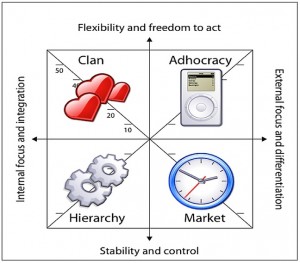 According to Robert E. Quinn and Kim S. Cameron at the University of Michigan at Ann Arbor, there are four types of organizational culture: Clan, Adhocracy, Market, and Hierarchy. Quinn and Cameron associate the lower two cultures (Hierarchy and Market) with a principal focus on stability and the upper two (Clan and Adhocracy) with flexibility and adaptability. A Hierarchy culture based on control will lead mainly to incremental change, while a focus on Adhocracy will more typically lead to breakthrough change. The right culture will be one that closely fits the direction and strategy of a particular organization as it confronts its own issues and the challenges of a particular time.
According to Robert E. Quinn and Kim S. Cameron at the University of Michigan at Ann Arbor, there are four types of organizational culture: Clan, Adhocracy, Market, and Hierarchy. Quinn and Cameron associate the lower two cultures (Hierarchy and Market) with a principal focus on stability and the upper two (Clan and Adhocracy) with flexibility and adaptability. A Hierarchy culture based on control will lead mainly to incremental change, while a focus on Adhocracy will more typically lead to breakthrough change. The right culture will be one that closely fits the direction and strategy of a particular organization as it confronts its own issues and the challenges of a particular time.
- Clan oriented cultures are family-like, with a focus on mentoring, nurturing, and “doing things together.”
- Adhocracy oriented cultures are dynamic and entrepreneurial, with a focus on risk-taking, innovation, and “doing things first.”
- Market oriented cultures are results oriented, with a focus on competition, achievement, and “getting the job done.”
- Hierarchy oriented cultures are structured and controlled, with a focus on efficiency, stability and “doing things right.”
